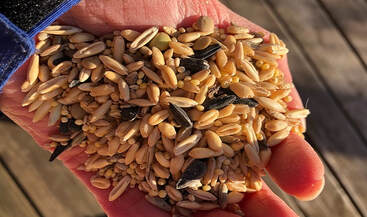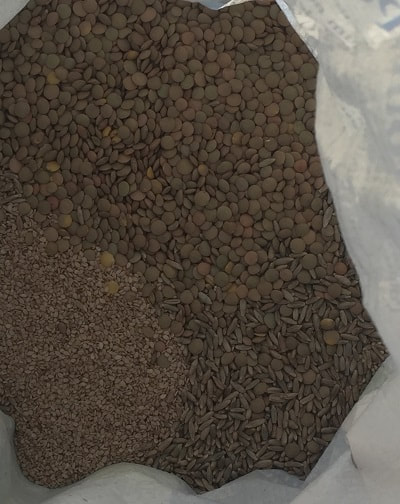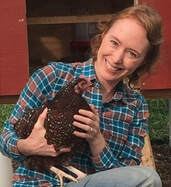
They have brought me so much entertainment, joy, laughter, and yes, some tears as well, and I literally look forward all day long to the end of the work day when I can see them again and tuck them in at night. (Yes, I might be a little bit obsessed...) :-) So it's no surprise that making my own chicken feed is important to me.
There is plenty of debate out there about what you should feed your chickens, and some of the chicken owner forums I often peruse feature hot arguments about whether or not you should ONLY feed commercial chicken feed.
Whatever you choose to feed your chickens is, of course, up to you, but I, for one, have opted for homemade whole grain feed instead. Below are some of the reasons why, as well as a great recipe and helpful resource that I use for mixing up my own nutritionally balanced chicken feed.
Whole Grain Feed Provides for Individual Nutrition
As do most animals, chickens (especially the heritage breeds that haven't had the smarts bred out of them) have great instincts when it comes to what is good for them to eat. Of course, they also have preferences, and like most animals (including humans), they may prefer "junk food" over the healthy stuff at times! This is why it is important to feed the correct amount, and also to prepare your feed mix in proper proportions for good health. As long as you provide a well-varied diet that contains all the nutrients they need, your chickens should be healthy.
Providing a mix of different grains with different nutritional properties also allows your chickens to choose the food that they need, which can vary depending on the time of year, laying and molting status, and more. In fact, I have noticed that sometimes my chickens will eat more or less of a certain thing from one day to the next.
For example, I include lentils and peas in my chicken feed for protein, which is important for laying hens. Legumes aren't their favorite thing to eat, so they often leave those until last. However, when they are molting, they will happily gobble up extra peas and lentils first thing, as their bodies need extra protein when they are growing new feathers. Therefore, I add an extra handful or so of these protein sources to their feed mix during the molt. Those who aren't molting will not eat the extra, while those who need it will.
It also allows the rooster to eat less protein than the hens, which is good as too much protein may cause health problems for him.
Making Your Own Feed Gives You Control
While proponents of commercial feed will protest that it is "specially formulated" to control all the nutrients chickens need, the problem with this is that, as mentioned above, your chickens may have different nutritional needs from each other - and even from day-to-day.
If you are feeding commercial feed, you have no way to change the nutrient profile of the feed based on what your chickens may individually need. You also don't necessarily know the quality of the feed ingredients, and of course, chicken feed is highly processed and at least some of the nutrients in the ingredients are destroyed during processing.
In fact, I somewhat doubt the truth of this claim anyway. Before I started feeding whole grains, I was feeding organic commercial feed crumbles, and I started to notice my chickens were always spreading a shower of dry skin flakes whenever they shook their feathers. I read that black oil sunflower seeds contained healthy fats and started adding some of these to their commercial feed every day. Not only do they LOVE these (like seriously - they eat them like they're candy!), but within a couple of weeks the dry skin issue completely disappeared.
Making your own mix allows you to control not only the nutrient profile, but also the source and quality of the ingredients. I choose to feed mostly organic as I have a great source of bulk organic whole grains that aren't too expensive, but even non-organic whole grains would be higher quality than what's in most processed chicken feed. I truly believe that soy and corn are junk foods and are no better for chickens than they are for humans!
Whole Grain Feed Is Better for Fermenting
As a fermentation aficionado, as soon as I heard that chicken feed can be fermented, of course I wanted to try it! I have read that some people ferment commercial chicken feed, but I don't see how that would work well... It would all dissolve and turn to mush! But it works great with whole grain feed, and smells lovely, sweet, and yeasty.
The benefits of fermented feed for your chickens are similar to the benefits of eating fermented foods for humans: they improve gut bacterial balance and help with digestion and immune support.
However, just as a human wouldn't eat an all-fermented diet, I don't feed only fermented feed to my chickens. They get a ration of fermented feed, and also a measure of dry feed as well. They seem to enjoy them both fairly equally, although the fermented feed is more problematic in the winter when it's very cold, as it tends to freeze solid in the feeder before they can eat it all... Therefore, I sometimes feed a bit less fermented feed on extra cold days.
Fortunately, since I use a similar mix for both fermented and dry feed, it's easy to vary the amounts or switch it up as needed, without any transition period.
These are the three main reasons why I opted for a homemade whole grain feed mix, but there are other reasons as well. The chickens absolutely love it, for one thing, and it's also a lot of fun to mix up all the different lovely grains! There's something very fulfilling about running your hands through the mounds of cool grains and seeds, smelling the nutty aromas, and realizing these beautiful ingredients are made by God without much intervention from humans, and they will be feeding us soon in the form of delicious, healthy eggs. :-)
You may be wondering, isn't it expensive to feed your chickens whole grains? The truth is that it could be - if I hadn't found an awesome online source of bulk whole grains... As it is, we do spend slightly more for our chicken feed than we would if feeding organic commercial layer pellets. But it adds up to only a few dollars extra per month.
To save a bit of money, I do add some commercial feed to the dry grain feed mix, in a 1-2 ratio. This also helps to stretch the grain a bit longer so that I can order a bit less often, since although it is delivered to local pickup site, it still isn't always that convenient for us.
I usually end up spending about $100 for a 4-month supply of feed grains, as opposed to about $20/month if I was feeding organic commercial layer feed. However, we do eat some of the organic lentils and peas ourselves as well.
Here is the recipe I use for making our own homemade whole grain chicken feed mix:
Whole Grain Chicken Feed Recipe (Soy & Corn-Free):
Yield: Makes about 2 week's worth of feed for 7 full-grown chickens
Ingredients:
4 parts whole oats (with hulls)*
4 parts black oil sunflower seeds
4 parts hard red wheat berries
2 parts soft white wheat berries (optional)**
2 parts rye berries
2 parts millet
1 part split peas or lentils***
1/2 part sesame seeds
1/2 part flax seeds****
Mixed Separately:
1/2 part brewer’s yeast
1/4 part kelp granules
We also provide a free-choice calcium supplement and grit to help them grind and digest the grains.
A Few Recipe Notes:
* My grain source is Azure Standard - an amazing family-owned company out West that delivers bulk organic foods nationwide at surprisingly affordable prices, and I get most of my chicken feed grains (and legumes) from them. They carry organic animal feed oats with hulls for about half the price of hulled oats. My chickens don't seem to love these, and I may try hulled instead at some point but haven't yet.
** I sometimes use just red wheat, or vary it up with white from time to time. My grain source carries organic chicken wheat which is usually red and is cheaper as well as higher in protein.
*** As I mentioned, while my chickens will eat legumes, they don't usually love them. In the beginning, they would get tired of one or the other and stop eating them, so I had to keep switching them out. Then I discovered that if I used one for the dry mix, and another for the fermented feed, they didn't seem to tire of them. I usually use lentils in the fermented mix, and peas in the dry, as they don't seem to like fermented peas very much. With this method, they almost never stop eating either of them.
**** Flax seeds create a gelatinous texture when mixed in water, so for the fermented feed mix, I add a couple of teaspoons of flax seeds to the mix AFTER fermentation and draining. In the dry mix, they go in with everything else.
The kelp and brewer's yeast are very high in important nutrients like iron and B vitamins, but my chickens won't eat dry powders, so I mix a couple of tablespoons of this supplement into the wet fermented feed after draining, where it sticks and they eat it right up.
As I mentioned above, I also add organic layer pellets to the dry feed mix in a 1-2 ratio, so for the batch size above, I would mix in 10 scoops of pellets. Also, for reference, the scoop I use is a 1-pint plastic beer cup.
This recipe was adapted from this one over at GardenBetty.com, and hers contains a few more ingredients. This is also where I got the awesome resource that made it possible for me to safely tailor the recipe while keeping the nutrients in balance... She offers a downloadable spreadsheet that calculates the protein, fat, and other content of these ingredients (and more) based on weight. So you just need to weigh your ingredients, enter the information in the spreadsheet, and it will calculate it all for you, based on the ingredients you are using! (If you enter the prices you pay for them, it will also tell you your per-batch and per-feed costs.)
My mix is slightly under 17% protein, and just over 9% fat. It costs about $10/batch, and each batch lasts about 2-3 weeks.
Chickens are omnivores (like humans), and they do best when their regular feed diet is supplemented with bugs, worms, greens, and other foraged foods. If you free-range your chickens, they likely get a good variety of these foods.
Our chickens are confined to their run for most of the day, as we have large numbers of hawks in our area, so we only allow them out to roam (inside poultry netting) in the later afternoon and early evening when we are at home to watch them. Therefore, I try to make sure to give them some greens every day - as long as I can scrounge some from the garden. They also get small amounts of appropriate kitchen scraps when available (see this article for what NOT to feed your chickens), and whatever they can forage while they are out.
Obviously, they are able to get a lot more greenery in their diets in the summer than winter, but I try to give them at least some every day. I keep kale and cabbage remnants growing in the garden as long as possible in the winter, and when those run out (usually in March or April), I sometimes feed some sprouted wheat or other sprouted grains.
My sweet chickies love their food, and they seem healthy and happy, especially now that most of them have grown gorgeous, thick and shiny new feather coats just in time for the deep winter cold! While it's not always fun to bundle up and trudge out through the freezing cold or blowing snow to bring them food and water, seeing them get so excited for their breakfast always brightens my day - no matter how tired, cold, or in a hurry I may be. :-D
If you want to make your own chicken feed as well, don't let the naysayers stop you! Read more at the links provided above (the Garden Betty articles have lots of helpful info), and just make sure you are feeding a varied diet with the proper amount of protein - especially if you have laying hens.
To healthy & happy chickens! :-)
Rose.





 RSS Feed
RSS Feed